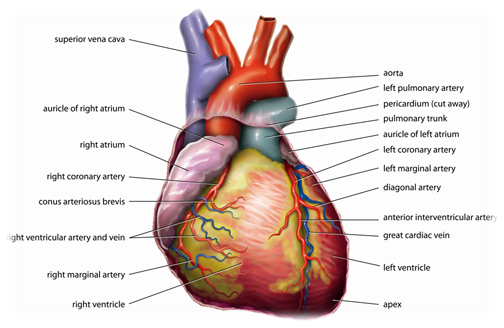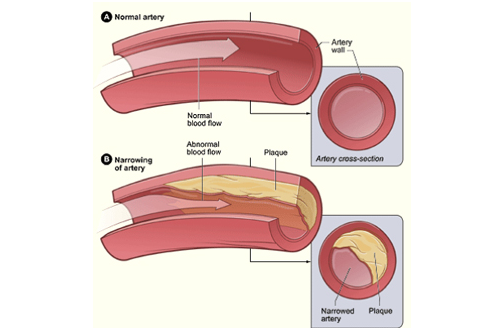About Heart:
About the size of our fist, heart is the most important organ of the body and it supplies the blood whole body. It contains four chambers (Right Atrium, Right Ventricle, Left Atrium and Left Ventricle). Right side of the heart (SVC&IVC->RA ->RV->PA) receives the blood from deoxygenated blood from the veins all over the body and it pumps blood through pulmonary artery into the lungs where it can be re oxygenated. The left side of the heart(LA->LV->AO) receives this oxygen rich blood from the lungs through pulmonary veins and supplies to whole body through Aorta (the major artery), and the entire cycle begins again.


What is Coronary Artery Disease (CAD) ?
Coronary artery disease (CAD) and also called as coronary heart disease (CHD). Heart disease is a result of plaque buildup in your coronary arteries -- a condition called atherosclerosis -- that leads to blockages. The arteries, which start out smooth and elastic, become narrow and rigid, restricting blood flow to the heart. The heart becomes starved of oxygen and the vital nutrients it needs to pump properly
How Does Coronary Artery Disease Develop?
From a young age, cholesterol-laden plaque can start to deposit in the blood vessel walls. As you get older, the plaque burden builds up, inflaming the blood vessel walls and raising the risk of blood clots and heart attack. The plaques release chemicals that promote the process of healing but make the inner walls of the blood vessel sticky. Then, other substances, such as inflammatory cells, lipoproteins, and calcium that travel in your bloodstream start sticking to the inside of the vessel walls. Eventually, a narrowed coronary artery may develop new blood vessels that go around the blockage to get blood to the heart. However, during times of increased exertion or stress, the new arteries may not be able to supply enough oxygen-rich blood to the heart muscle.
In some cases, a blood clot may totally block the blood supply to the heart muscle, causing heart attack. If a blood vessel to the brain is blocked, usually from a blood clot, an ischemic stroke can result. If a blood vessel within the brain bursts, most likely as a result of uncontrolled hypertension (high blood pressure), a hemorrhagic stroke can result.
What Are the Symptoms of Coronary Artery Disease?
The most common symptom of coronary artery disease is angina, or chest pain. Angina can be described as a heaviness, pressure, aching, burning, numbness, fullness, squeezing or painful feeling. It can be mistaken for indigestion or heartburn. Angina is usually felt in the chest, but may also be felt in the left shoulder, arms, neck, back, or jaw. Other symptoms that can occur with coronary artery disease include:- Shortness of breath
- Palpitations (irregular heart beats, skipped beats, or a "flip-flop" feeling in your chest)
- A faster heartbeat
- Weakness or dizziness
- Nausea
- Sweating
How Is Coronary Artery Disease Diagnosed?
Your doctor can tell if you have coronary artery disease by:- Talking to you about your symptoms, medical history, and risk factors.
- Performing a physical exam.
- Performing diagnostic tests, including an electrocardiogram (ECG or EKG), exercise stress tests, electron beam (ultrafast) CT scans, cardiac catheterization, and others. These tests help your doctor evaluate the extent of your coronary heart disease, its effect on the function of your heart and the best form of treatment for you.
